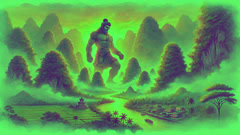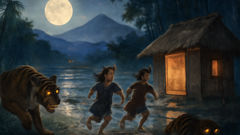Introduction
There is a hush that falls over the valleys of northern Vietnam when the mists coil along the slopes and the mountains rise in silent watchfulness. The rivers wind through fields of shimmering rice and the bamboo groves whisper stories that have traveled on the wind for centuries. In this ancient landscape, every ridge and hollow seems to remember. The people who have lived beneath these peaks have always believed that the land itself was shaped by hands — or feet — far greater than their own. The legend of Tay-Boday, the giant who strode between mountains and carved the earth beneath his feet, is woven into the spirit of these highlands. It is told from fireside to fireside, across generations, with reverence for a time when giants walked the land, and nature and humanity found their place in a world brimming with wonder.
Long before cities rose and roads snaked through the valleys, Vietnam was a tapestry of endless green, broken only by the bold thrust of mountains and the silver ribbon of rivers. The people lived in harmony with the land, their small villages nestled in the folds of hills, sustained by the bounty of the earth and the stories passed down by their ancestors. Among these stories, none was more beloved than that of Tay-Boday. He was not a monster to be feared, but a guardian to be admired — a being of such immense strength and kindness that the land itself bore the marks of his passage. The villagers would point to the sweeping valleys, the sudden clefts in the mountains, and say, "Here, Tay-Boday walked. Here, he rested. Here, he saved us."
This tale is not only about the power of the giant, but about the delicate balance between humanity and the natural world. The people of the land understood that their survival depended on respecting the spirits of the forests, the rivers, and the mountains. In Tay-Boday, they saw an embodiment of that balance: a force as gentle as it was mighty, who could shape rivers with a step but also shelter a village with his hand. The legend was a guide and a comfort, a reminder that the earth was alive with memory, shaped by forces both seen and unseen. The story of Tay-Boday continues to ripple through time, inviting new generations to wonder at the world around them and cherish the landscapes that hold their own legends.
The Birth of Tay-Boday and the Ancient Land
Long before the first kings claimed their thrones, before men built houses of stone or named the rivers, the land that would become Vietnam was a place of undisturbed majesty. The mountains rose like the backs of ancient dragons, wrapped in clouds and mystery. The forests stretched unbroken from horizon to horizon, and the rivers ran silver and free through the deep green. The people who called this land home believed that every rock, every tree, every gust of wind was alive with spirit and purpose.
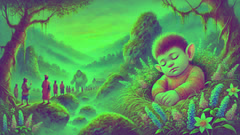
Into this world was born Tay-Boday, whose name means simply 'the giant who strides between mountains.' He was not born of human parents but sprung from the earth itself, the offspring of the mountains and the sky. The story goes that on a night when the stars burned brighter than ever before, thunder rumbled between the peaks and lightning danced along the ridges. In the morning, as dawn touched the highest summits, the villagers discovered a child sleeping in a nest of wildflowers, his breath soft as the mountain mist. He was larger than any newborn the world had seen — so large that the grass beneath him flattened for ten paces in every direction. The wise woman of the village declared him a blessing from the mountains, a protector sent in answer to the silent prayers of the people.
Tay-Boday grew swiftly, nourished by the pure water of mountain springs and the fruits of ancient trees. By the time he was a year old, he towered above the tallest men; by his fifth birthday, he could reach the lowest branches of the tallest trees without stretching. His laughter rolled across the valleys like distant thunder, and his footsteps sent pebbles tumbling down the slopes. Yet there was never malice in his heart. He helped the villagers harvest rice, moving great stones so easily it seemed the earth obeyed him. When floods threatened, he scooped new channels for the water to flow. When wild animals prowled near, he stood guard at the edge of the fields, his presence alone enough to keep danger at bay.
As Tay-Boday grew, so did the legends around him. Travelers from distant lands came to see the gentle giant who could uproot whole trees with a single hand, who could dam rivers with a fallen log or divert streams with a sweep of his arm. The elders watched with pride and a touch of awe. For all his strength, Tay-Boday was kind and wise. He understood the delicate balance of nature, never taking more than was needed and always restoring what he moved. The people learned from him, and their lives flourished in harmony with the rhythms of the land.
Yet there were some who whispered that such power could not exist without envy. Spirits jealous of Tay-Boday’s might stirred in the hidden places of the earth. The wind sometimes brought strange howls from deep within the forest, and shadows moved restlessly among the bamboo. The villagers watched their giant protector with renewed gratitude, for as long as he strode among them, no harm could touch their homes or their fields.
One morning, as Tay-Boday stood atop a high ridge watching the sun rise over the green sea of trees, he felt a stirring in his heart — a call that seemed to come from the very bones of the earth. He knew, as surely as he knew his own strength, that his destiny was entwined with the land itself. He would walk where the mountains called him, shaping the valleys and rivers with every step, leaving behind a world more beautiful, more abundant, and more alive than before.
Tay-Boday’s Great Journey: Carving Valleys and Shaping Rivers
With every passing year, Tay-Boday’s legend grew alongside his stature. By the time he had reached his full height — taller than the tallest peak, broad as a forested hillside — he knew it was time to answer the call that echoed in his heart. On the first day of the dry season, he said farewell to his village, kneeling to thank the elders who had raised him and the children who had danced in his shadow. The villagers wept, for they knew that his journey was necessary, and that the world beyond needed his gifts as much as they had.
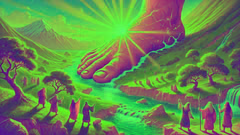
Tay-Boday’s strides were mighty. In three steps, he could cross a valley; in a single afternoon, he could disappear into the farthest horizon. Where his feet pressed into the earth, the ground softened, then split, forming wide valleys that would later cradle rivers and lakes. The echo of his footsteps sent herds of deer racing through the underbrush and startled flocks of birds into flight. Yet all creatures sensed his gentle purpose and soon returned to their homes, finding new places to nest in the hollows and clefts he left behind.
There are many stories told of Tay-Boday’s journey. In one, he came to a land where two mighty mountains stood so close together that not even the sun could shine between them. The people who lived in their shadow suffered in darkness, their fields cold and their hearts heavy. Tay-Boday placed his enormous hands on each peak and gently pushed them apart, opening a passage for sunlight to pour through. Where his feet pressed into the earth, a new valley formed, and a clear river began to flow, bringing warmth and life to the land below.
In another tale, a terrible drought gripped a distant province. The rivers had dried to a trickle, and the people’s crops withered under the relentless sun. Tay-Boday strode across mountains and forests, seeking the source of the drought. Finding a massive boulder blocking the spring at a mountain’s heart, he lifted it aside and gouged a channel with his heel. Water burst forth in torrents, racing down the slope and filling the empty riverbeds. The grateful villagers celebrated with feasts and dances, naming the new river for their giant benefactor.
Tay-Boday’s journey was not without trials. The envious spirits that had long whispered in shadows now gathered their strength. They sent storms that lashed at him with rain and wind, tried to trip him with roots and rocks, and conjured illusions to lead him astray. But Tay-Boday’s wisdom was as great as his strength. He listened to the voices of the birds, followed the patterns of moss on the stones, and watched the way the clouds moved across the sky. With patience and kindness, he calmed the spirits’ anger, promising to care for the land and all its children.
Along the way, Tay-Boday met people from many villages. Some were frightened at first, hiding behind trees or peering from their windows. But when they saw how he gathered fallen trees to build bridges, shaped new fields with his hands, and listened to their songs and stories, they welcomed him as a friend. Children would laugh and chase after his enormous footprints, while elders taught him the secrets of local herbs and ancient tales. In every place he visited, Tay-Boday left gifts: a new valley for planting, a spring for drinking, a grove for shelter.
The years passed, and Tay-Boday’s journey shaped the very heart of Vietnam. Where there had been tangled forests too dense for sunlight, he opened glades where birds now sang. Where rivers had once vanished into the earth, he drew new channels with his fingers, ensuring that water would reach even the farthest fields. Each step, each act of kindness, became part of the land itself — a living testament to the bond between people and nature, strength and gentleness.
The Giant’s Gift: Harmony and Remembrance
As time passed, Tay-Boday’s legend became inseparable from the land itself. The valleys he carved grew lush with rice paddies and bamboo groves. Rivers ran strong and clear, nourishing fields where farmers sang as they worked. Forests flourished in the shelter of mountains gently parted by his hands. The people lived in peace and prosperity, their stories growing richer with every generation.
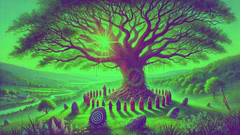
But even giants must rest. As Tay-Boday walked, he began to feel the weight of his journey. The land no longer called him with restless urgency; instead, it sang to him, a lullaby carried on the wind. One evening, as twilight settled over a valley cradled by gentle slopes, Tay-Boday sat beside a great boulder overlooking a village he had once helped. He gazed down at the flickering lanterns and listened to the laughter drifting upward. Children played among his footprints, now filled with water and ringed by wildflowers. The world was at peace.
Knowing his task was nearly done, Tay-Boday decided to leave a final gift. He gathered stones from the riverbed and built a circle atop the highest hill. Within it, he planted a seed from an ancient tree, one said to hold the wisdom of all forests. He cupped his hands around it and whispered words of blessing, calling on the mountain and sky to protect it always. The tree grew swiftly, its branches stretching wide to shelter all beneath. It became a gathering place for celebrations and stories, a living memory of the giant’s kindness.
As dawn broke over the mountains, Tay-Boday rose for the last time. He gazed across the land he had shaped and smiled, knowing that every valley, river, and field would remember him. Then he walked toward the horizon, his silhouette fading into the morning mist. Some say he became part of the mountains themselves, his spirit resting in the stones and streams. Others believe he still wanders in distant lands, shaping new worlds with every stride.
The people never forgot their gentle giant. Each year, at the festival of rivers and mountains, they gather at the ancient tree to tell his story. Children dance in circles that follow the path of his footsteps; elders recount how Tay-Boday’s wisdom taught them to live in harmony with nature. When storms threaten or droughts linger, they remember his promise — that as long as they care for the earth and each other, Tay-Boday’s spirit will guide and protect them.
So it is that, in every mountain valley and along every winding river of Vietnam, the legend of Tay-Boday lives on. The land itself is his legacy — a testament to strength joined with gentleness, and a reminder that even the greatest among us leaves their mark not through force alone, but through acts of kindness that ripple across generations.
Conclusion
The legend of Tay-Boday is more than just a story told to chase away the darkness or explain the valleys and rivers that shape Vietnam’s landscape. It is a living memory, echoing through generations as a reminder of how closely people are tied to the land beneath their feet. Where the mountains rise and rivers wind, Tay-Boday’s spirit endures — in every act of kindness, in every effort to live in harmony with nature. His footsteps remind us that even the mightiest power is most beautiful when tempered with wisdom and compassion. Through Tay-Boday’s journey, we learn that true greatness is not measured by what we take from the world, but by what we leave behind: a legacy of harmony, hope, and stories that inspire those who follow. As long as children laugh among wildflowers and elders gather beneath ancient trees, the giant’s memory will live on — quietly shaping hearts as surely as he once shaped valleys and rivers.

